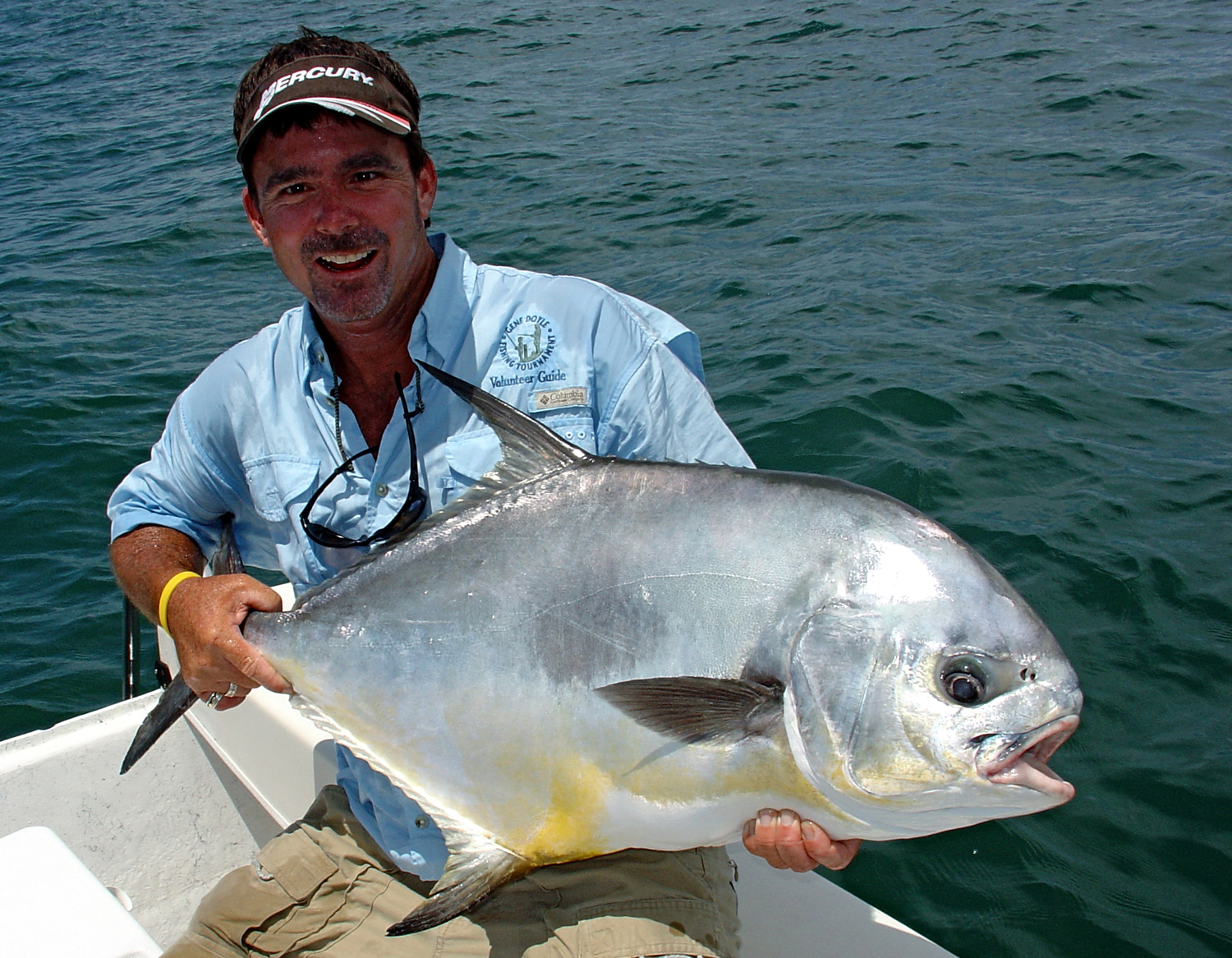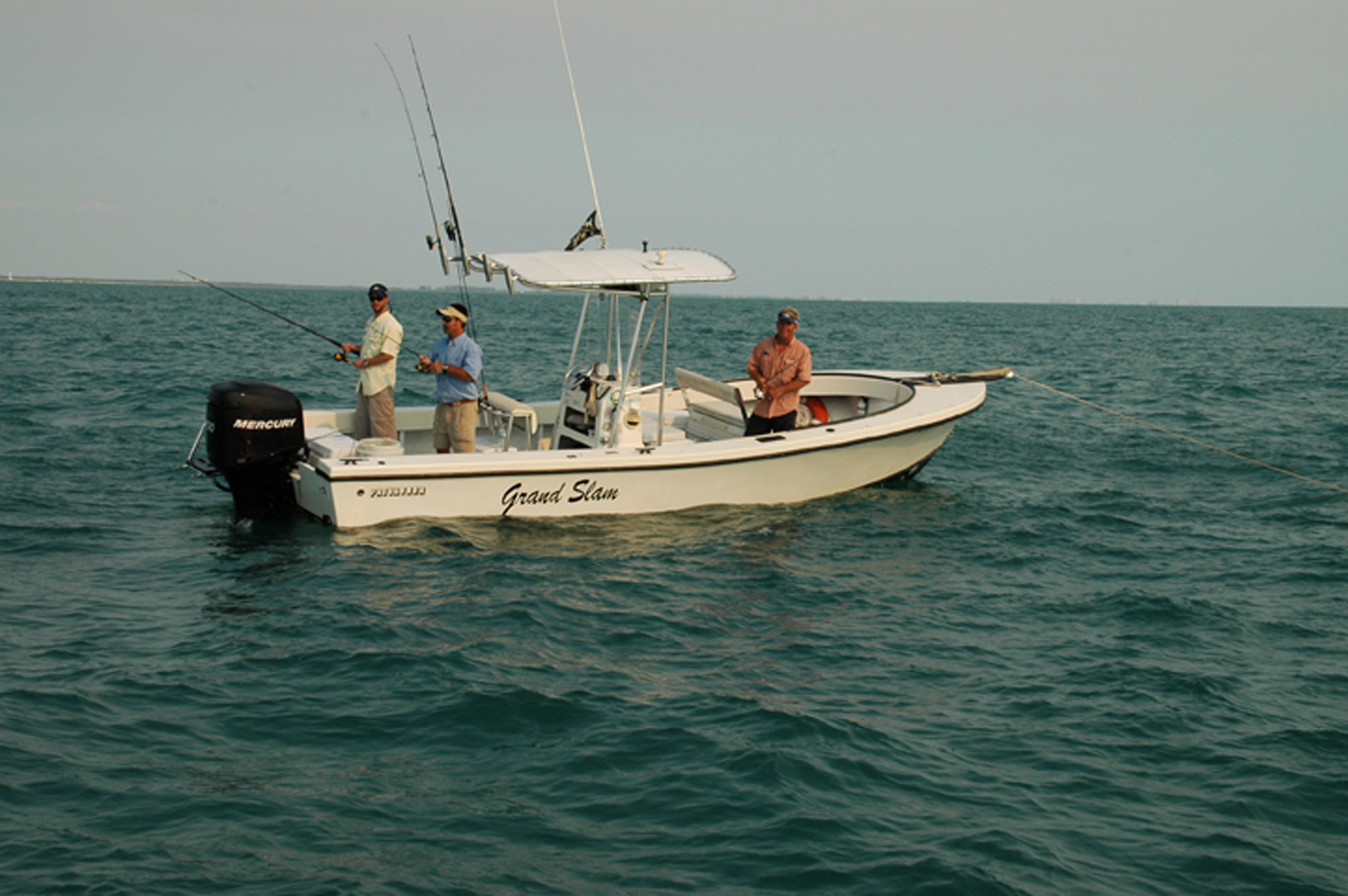February 24, 2012
By Will Geraghty
Catch world-class fish where you might not expect them.
 Captain Will Geraghty with a Naples permit.
Captain Will Geraghty with a Naples permit.
Our goal for the day was to tackle bruiser permit, 40-pound-class fish that I had been picking at for several weeks. The school of about 100 finicky, wary fish had dodged local angling pressure, and as luck would have it, they were chewing. Visiting from Pennsylvania, my client Ray Augustonelli went three for five that afternoon, with his largest permit catch nearly pushing the half-century mark.
Dialing in to these challenging, migratory gamefish requires intuition, a sound technical approach, and most importantly, an intimate knowledge of “what lies beneath.”
Off southwest Florida, a structure-rich coastline gives way to barren stretches of sand as one pushes westward. Here and there, various pelagic and bottom fish gravitate to scattered patches of soft coral, sea fan forests, limestone “swiss cheese” bottom and small ledges.
The biggest attraction for permit is the region's artificial wreck and reef system. Location, mass and vertical relief is the winning combination for epic, tackle-busting battles and world-class permit catches.
Stealth Tactics in the Deep
At times permit are easy to fool; at other times, definitely not. Some fishermen are surprised to learn that stealthy, shallow-water flats tactics actually have a place on deepwater structure. Also, specialized tackle can help entice takes, hookups and subsequent landings.
Two schools of thought exists on how to effectively approach spooky permit on the wrecks--anchoring or drifting.
Drifting can be deadly when smooth seas, light current and calm winds prevail, or when plying the wrecks late in the seasonal run. This is the best way to get shots at “cruising” or “cycling” permit. Start by locating or marking the targeted structure and determining drift direction quietly and expeditiously. Spooked by deck and engine noise, it often takes several minutes or longer for a school of permit to settle down and return to the area. Through seasons of trial and error, I have found that a drift distance away from the wreck of 75 to 100 feet is sufficient for casting accuracy while still allowing for the ability to sight and cast to surface or sub-surface “cruisers.” Remember to lead the fish by a minimum of three feet when casting to them.
 Anchored upcurrent of a small wreck, Geraghty and anglers drift baits for permit.
Anchored upcurrent of a small wreck, Geraghty and anglers drift baits for permit.
As effective as drifting may be, anchoring is my preferred method. Again, it begins with a stealthy approach while locating the desired structure, and setting the anchor 50 to 100 feet upcurrent. Once firmly on the hook, baits can be effectively broadcast over and on the periphery of the structure below.
At anchor, odds are you might have to chase a fish. Have a float rigged up at the end of your anchor line so that you can quickly unhitch and dump the line. It's much quicker than pulling the anchor, and best of all you can return to the same spot after you've landed the fish.
Tackle and Rigs
 Key bait for permit on the wrecks: live crab hooked in the corner of the shell.
Key bait for permit on the wrecks: live crab hooked in the corner of the shell.
Aboard my Grand Slam we're rigged and ready prior to departing the dock, with a full quiver of 7-foot, 12- to 20-pound-class rods matched with braid-ready spinning reels. I favor the Penn Conquer reels, which have 10 shielded stainless steel ball bearings, infinite anti-reverse, and smooth drags. The key feature in an offshore permit reel, regardless of brand or model, is the capability to wind braided polyethylene line tightly and evenly on the spool. You want the no-stretch braid to help haul fish away from jagged structure, and the low diameter relative to monofilament seems to afford better casting distance with the lightly (or un-) weighted crab baits. I'm using SpiderWire Ultracast Invisi-Braid on the wrecks; it's a “round” braid, and durable.
The go-to bait for permit success on the wrecks is, without fail, a live crab. At the same time, these fish may be fooled by Merkin-style fly patterns, natural color bucktail jigs, scented synthetic crabs (such as the Gulp!), and jumbo live shrimp.
Some days you can dip “local” or “swimming” crabs right out on the Gulf waters. However, prudent anglers will never leave the dock without a livewell full of “pass” or “silver dollar” sized crabs purchased through a local outfitter or bait shop.
While permit are justifiably regarded as line-shy fish, aboard my boat we play to win. That means tying on liberal lengths (10 to 20 feet) of 40-, 60- and even 80-pound (on occasion) fluorocarbon leader; I use an Albright special knot. The long shock leader terminates at a stout, 2/0 or 3/0 circle hook. The reason for the leader, again, is the wicked structure we're typically fishing around.
With live crabs, the hook is inserted into a corner of the carapace, from bottom to top. Do this carefully, twisting to ensure you don't fracture the shell and fatally injure the bait.
To canvas the entire water column, baits should be freelined, fished on a small cork, or accompanied by a small pinch of lead. Pay close attention to which method produces, as a definitive bite pattern typically develops.
While permit are certainly good eating, most fishermen choose to release these big permit after detaining them briefly in a big net or by hand alongside the boat. On the wrecks or on the flats, permit are an exciting catch, limited to just a few warm months of the year in most regions of Florida.
Permit Regulations
Aggregate Bag
The way the Florida state law is written, you may not keep more than 6 permit and pompano in any combination; it's called an aggregate bag. Three pompano and three permit would fill a bag limit, for example.
The two species are grouped this way because they are very hard to distinguish from the other.
Slot Limit
Minimum size for the two species is 11 inches, measured from the forwardmost tip of the head to the fork of the tail. Maximum is 20 inches. That's called a slot limit.
Trophy Fish Allowance
As part of the aggregate bag limit, an individual fisherman may keep one permit or pompano over 20 inches fork length. That means one or the other, not one of each.
Vessels are limited to no more than 2 permit and pompano over 20 inches. Say it's you and three buddies, and two of you keep 24-inch permit, while the other two keep a pair of 24-inch pompano. You're good—as long as you're 100-percent certain those two big pompano are actually pompano, which at that size, they probably aren't. . .
Another wrinkle: If you're fishing by yourself, you may not legally retain that vessel limit of two oversize fish. The individual limit comes first, vessel second.
When in doubt, be conservative.
Look for the new Florida Sportsman Gulf and Atlantic Coast Lawsticks at tackle shops near you or online at www.floridasportsman.com.
FS
